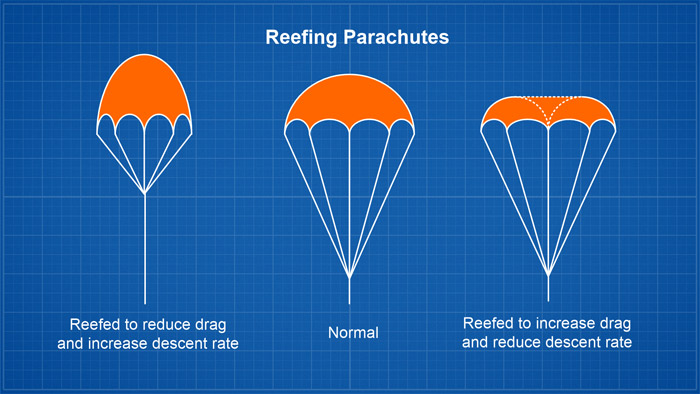| Date: | 25th June 2016 |
| Location: | Whalan Reserve, Australia |
| Conditions: | Clear skies, windy 15km/h, 8-12C |
| Members: | PK, GK, Paul K and John K |
A few years ago we looked at classic parachute reefing (Day 114 Reefing Parachutes) in order to reduce parachute drag by tying the shroud lines together. This is useful for increasing the descent rate of your rocket in order to reduce drift in windy conditions or prevent a parachute from shredding during high speed deploys when something like a reefing ring is used. The question though is, is there another reefing technique that will increase the drag of the same sized parachute? Indeed there is.
When we bought an Aerocon 36" chute it had a central reefing line, and came with a description that the line makes it into an effective 44" chute.

So this week we compare the descent rates between parachutes with and without that central reefing line. For people flying their rockets in time-of-flight competitions this may be an easy way to increase flight time without significantly changing the weight of the rocket. It is also applicable where you don't have enough room for a larger parachute on an otherwise heavier rocket.
If we have a look at the parachute descent rate calculations we can theoretically compare a 36" chute with a 44" one. The following formula gives us the descent rate (v):
v = sqrt( (8 m g) / (π ρ Cd D2) )
Where:
m = mass of the rocket in Kg
g = acceleration due to gravity (9.8 m/s2)
ρ = density of the air (1.22 kg/m3)
Cd = Drag Coefficient of the parachute (0.75 for parasheet. 1.5 for
hemispherical parachute)
D = The diameter of the parachute in m.
If we assume a rocket weight of 550g we get descent rates of 4.23 m/s and 3.46 m/s for the 36" and 44" chutes respectively. That's a reduction in descent rate of 18% with the reefing line in place.
This experiment aims to see if the theoretical calculations reflect real world performance. For this experiment we made a small hole in the top of a parachute and glued a nylon ribbon cross across the hole so that we could put a loop of string over it. We also made the extra shroud line with a spring clip on the end of it so we could easily connect and disconnect it when needed.
To measure the descent rates we mounted the zLog recording altimeter to the rocket and suspended the rocket sideways so that it would have a stable attitude on the way down. We didn't want the rocket to be swinging under the parachute changing the drag coefficient of the entire rocket-parachute system. We also mounted a camera on a little platform on the shroud lines so that we could watch the parachute during descent to see if it had any stability issues with the reefing line in place. We used our Axion II rocket for this experiment.
Because it was really windy on the day we only launched at 100psi to keep the peak altitude lower and stop it from drifting too far. We weren't after any particular altitude we just wanted to see how fast the rocket would fall.
We flew the rocket 3 times with the normal parachute and 3 times with the parachute reefed. In all cases the parachutes opened cleanly, and both the reefed and normal were stable. You could see that in the on-board video. Suspending the rocket horizontally sideways had the effect of causing the rocket to fly around in a circle which caused the parachute to also be angled in relation to the ground.
Here are the altitude plots from the flights:

We then looked at the portion of the descent that was relatively stable and calculated the rate:
| Flight | Parachute | Time Interval (s) | Altitude Change (feet) | Descent Rate (feet/s) |
| 1 | Normal | 7.24 | 207-13 | 26.8* |
| 2 | Reefed | 22.87 | 232-12 | 9.6 |
| 3 | Reefed | 14.12 | 195-12 | 12.9 |
| 4 | Normal | 16.75 | 204-11 | 11.5 |
| 5 | Normal | 8.3 | 137-17 | 14.4 |
| 6 | Reefed | 13.91 | 172-10 | 11.6 |
* We ignore Flight 1's measurement because the rocket-parachute had spun significantly on the way down increasing the descent rate.
If we average the descent rates for the normal parachutes we get a descent rate of: 12.95 feet/s (3.95 m/s) and for the reefed parachutes we get a descent rate of: 11.4 feet/s (3.47 m/s). This turns out to be a 12% reduction in descent rate with the reefing line in place which agrees with the theoretical predictions.
| Launch | Details | ||||||||||||||||||||||||
| 1 |
|
||||||||||||||||||||||||
| 2 |
|
||||||||||||||||||||||||
| 3 |
|
||||||||||||||||||||||||
| 4 |
|
||||||||||||||||||||||||
| 5 |
|
||||||||||||||||||||||||
| 6 |
|